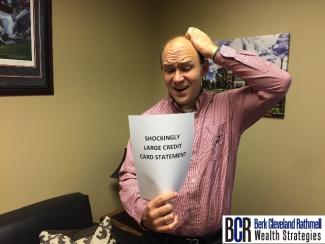
Know What You're Spending
One of the first questions we ask a new client is, "How much do you spend on a monthly and annual basis?" Half the people we ask have no idea, and the other half are usually wrong! Once we determine their actual spending, we discover that their "guesses" were usually low.
A gap between what you spend and what you think you spend can be very dangerous to your financial health because there are so many things you can get wrong if you don’t get this right.
Here are four targets you’ll miss without a good handle on your spending patterns:
1. Monthly cash flow. Unless you work on commissions, it's probably easy to know how much you are bringing in each month. But if you don't know how much is going out, you can have cash flow issues down the line. If you're spending more than you're making, you are going to run out of funds at some point.
2. An adequate emergency fund. We help our clients determine how much cash they should have on hand in case an emergency such as losing a job, incurring unexpected medical expenses, or expensive car repairs. You have to know how much you spend in a month to determine how much needs to be in your emergency fund.
3. Retirement savings targets. Most of your lifestyle expectations in retirement are based on how much you spend. You could be saving too much and not using assets you could spend today, but it's more likely you aren't saving enough because you underestimate your monthly spending. If you don't know how much it takes to maintain your lifestyle now, you can't accurately calculate how much it will take to maintain it in retirement and how much you must save to make that possible.
4. Planning for incremental increases that come with major purchases. If you make a purchase that increases your expenses, such as buying a house, you could easily buy more than you can afford. You need to know the true margin between your income and your expenses. This is why so many become house poor. They think they can make adjustments to their spending in other categories, but they frequently don’t find out until after they’ve bought the house that most of their spending isn't actually adjustable, and they usually feel the adjustments they can make are a heavy sacrifice.
How to find out what you actually spend
Our favorite way to help clients get a grip on what they spend is by teaching them to use one of the many free budgeting platforms that helps you track your income and expenses. The important thing to remember is that free always comes at a cost. These programs will give you recommendations that are many times in line more with who is paying them than your best options. Use them for the budgeting but be wary of their suggestions. We've also seen people succeed with a good Excel spreadsheet, QuickBooks, and other programs.
Tracking your spending for a month or two is a good start, but you can't stop there. A great budget takes time to perfect. Many expenses, like property and ad valorem taxes, are billed annually, so you need at least 12 months to get a complete picture of your spending.
We aren't saying you must know what you're spending down to the penny, but you absolutely must ensure there is not a significant gap between your actual spending and your best guess. The success of your financial plans depends on it.
-Marshall Rathmell-

